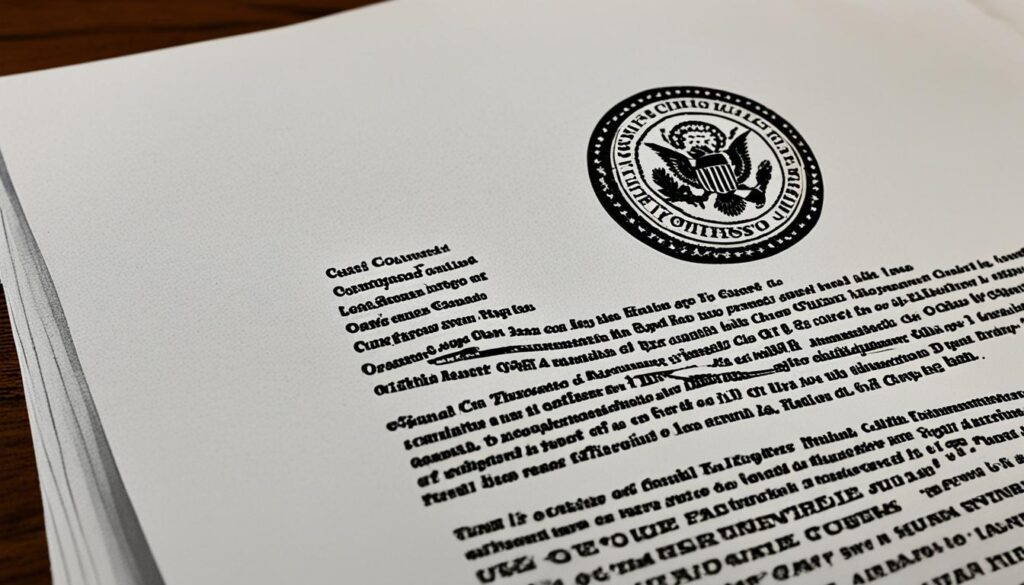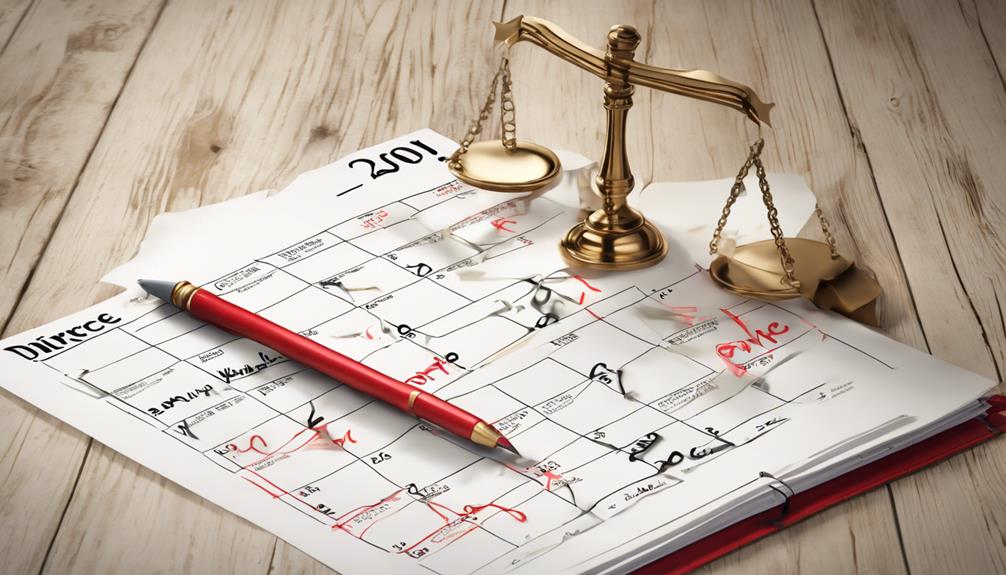Did you know that approximately 70% of women who have experienced a divorce choose to go back to their maiden name? The choice to change one’s name during or after a divorce is a common decision that many people face as they navigate the challenges of rebuilding their lives. Whether you are considering reverting to your maiden name or selecting a new name of your liking, this article is intended to offer a comprehensive guide to help you navigate this process smoothly and confidently.
Key Takeaways:
- Changing your name after a divorce is a personal decision that carries emotional weight and practical implications.
- Obtaining your divorce decree with a name change provision can simplify the name change process.
- Gathering legal proof of your former name, such as your birth certificate or marriage certificate, is crucial for a successful name change.
- Filing a petition for name change with your local court and attending the court hearing are necessary steps in the name change process.
- Updating important records, such as your social security card, driver’s license, and passport, is essential after a name change.
Understanding the Importance of Name Changes
A name is not just a mere string of characters, but an intricate part of one’s identity, intertwined with personal history, accomplishments, and cherished memories. In the aftermath of a divorce, individuals often contemplate changing their name as a symbolic gesture to reclaim their pre-marital identity or embrace a new one. This deeply personal decision holds profound emotional significance and carries practical implications, allowing for self-redefinition and healing.
Embracing a new name can serve as a powerful tool to rediscover one’s individuality and forge a path towards personal growth. It allows for the expression of autonomy and signals a fresh start, empowering individuals to shape their future on their own terms. By changing their name, individuals can draw a clear line between past experiences and future aspirations, fostering a sense of liberation and renewed purpose.
“A name is not just an arbitrary label, but a thread that weaves together the tapestry of our existence. Choosing to change one’s name after a divorce is a personal decision that reflects an individual’s journey towards self-discovery and self-empowerment,” says Dr. Rebecca Anderson, a renowned psychologist specializing in personal transformation.
Your name is more than just a collection of letters; it carries the weight of personal history, achievements, and memories. Whether reclaiming a pre-marital name or embarking on a new one, changing your name after a divorce is a profound decision that embodies the significance of individuality, self-expression, and personal choice. It serves as a tribute to your resilience and ability to shape your own destiny.
Obtaining Your Divorce Decree
The divorce decree is an essential document that signifies the end of a marriage. It not only legally dissolves the union but also often includes a provision for a name change, which can make the process easier and faster for individuals seeking a new identity. Obtaining a divorce decree is the simplest and fastest way to change your name after divorce.
If your divorce decree includes a name change provision, you can use it as legal proof to update your name on various official documents. This provision eliminates the need for additional legal proceedings and simplifies the name change process. By having the decree, you can swiftly move forward in reclaiming your identity.
However, if your divorce decree does not include a name change provision, don’t worry; there are still steps you can take to change your name legally. In such cases, you will need to follow the standard legal procedures for a name change, which may involve filing a separate petition with your local court.
If your divorce decree does not include a name change provision, there are still steps you can take to change your name legally.
Changing your name through a divorce decree is highly favored due to its convenience and straightforward nature. It eliminates the need for additional paperwork and court appearances, streamlining the process for individuals seeking a fresh start with a new name.
Divorce Decree Name Change Provision
The name change provision in a divorce decree allows individuals to change their name without undergoing a separate legal process. This provision is usually included in the decree to accommodate the needs and preferences of the divorcing parties. By including this provision, the court acknowledges the desire for a name change and provides the necessary legal authority for the change to occur.
Having a name change provision in your divorce decree significantly simplifies the name change process. It serves as legal proof of your right to adopt a new name and eliminates the need for additional hearings or filings. By presenting the divorce decree to relevant authorities, you can change your name on various documents without further hassle.
It is important to note that the availability of a name change provision in a divorce decree may vary depending on the jurisdiction and specific circumstances of the case. It is advisable to consult with your attorney or legal advisor to understand the provisions and requirements specific to your situation.
Here is an example of how a divorce decree with a name change provision may look:
| Divorce Decree with Name Change Provision |
|---|
 |
By obtaining your divorce decree with a name change provision, you can expedite the process of legally changing your name after divorce.
Gathering Legal Proof of Your Former Name
In order to change your name legally, you will need to gather documents that serve as legal proof of your former name. These documents may include your birth certificate, old passport, or marriage certificate. Having these documents is crucial as they provide evidence of your previous identity and are required for the name change process.
Documents Needed for a Name Change:
| Type of Document | Explanation |
|---|---|
| Birth Certificate | Proof of your original name |
| Old Passport | Evidence of your former name if you have one |
| Marriage Certificate | If applicable, to demonstrate your current and former names |
By presenting these legal proofs, you can substantiate your request for a name change and ensure a smooth transition. Remember to keep these documents in a safe place and make copies as needed.

Filing a Petition for Name Change
If your divorce decree does not include a provision for a name change, you will need to file a petition for a name change with your local court. This step-by-step guide will walk you through the process of filing a petition and provide valuable insights to ensure a successful name change.
Step 1: Complete the Petition
The first step is to complete the petition for a name change. The petition will require you to provide your personal information, including your current and former name, contact details, and reasons for the name change. Be sure to fill out the form accurately and provide all requested information.
Step 2: Attach Divorce Decree and Evidence of Former Name
Next, you will need to attach your divorce decree as evidence of your eligibility for a name change. This document confirms the end of your marriage and serves as legal proof for the court. Additionally, gather any evidence of your former name, such as your birth certificate or old identification documentation.
Step 3: Pay the Filing Fee
When filing your petition, you will be required to pay a filing fee. The fee amount varies depending on your jurisdiction, so be sure to check with your local court for the specific cost. Keep in mind that some courts may offer a fee waiver or reduction based on your financial situation.
Step 4: Publication Notice
In many jurisdictions, it is a legal requirement to publish a notice in a newspaper indicating your intent to change your name. This publication notice serves as a public announcement and allows anyone with objections to come forward. The court will provide you with instructions on how to complete this step, including the newspaper selection and timeframe for publication.
Important Considerations
“Filing a petition for a name change is a crucial part of the process, and it’s essential to understand the specific requirements in your jurisdiction. Consult with an attorney or seek guidance from the local court to ensure you follow all necessary steps and meet the legal obligations.”
Completing and filing a petition for a name change can be a complex and time-consuming process. However, with proper guidance and adherence to the local court’s instructions, you can navigate this step successfully. Remember to gather all required documents, pay the filing fee, and comply with any publication notice requirements to ensure a smooth name change process.
Attending the Court Hearing
After filing your petition for a name change, the next step in the process is attending a court hearing. This hearing provides an opportunity for a judge to review your request and ensure that you have a legitimate reason for the name change. Don’t worry; this step is typically a formality, especially if you have provided ample support for your name change.
During the court hearing, be prepared to answer any questions the judge may have. The judge’s main concern is ensuring that the name change is your choice and not for any fraudulent or ill-intentioned purposes. It is essential to provide legitimate reasons and demonstrate your commitment to the name change.
“The judge’s main concern is ensuring that the name change is your choice and not for any fraudulent or ill-intentioned purposes.”
Having evidence or support for your name change can strengthen your case. This may include documents such as divorce papers, financial records, or personal statements explaining the rationale behind your decision. The judge may also consider any legal or cultural factors that may influence your chosen name.
Remember, the court hearing is an opportunity for the judge to fully understand your situation and determine if the name change is appropriate. Approaching the hearing with a calm and respectful demeanor can go a long way in facilitating a smooth process.

Once the judge approves your name change request, the next step is receiving the official order for name change from the court. This document serves as legal proof of your new name and is essential for updating your records.
Receiving the Order for Name Change
If your name change request is approved, you will receive an order for name change from the court. This document serves as legal proof of your new name and is required for updating all of your records. It is important to obtain certified copies of the order for name change as you will need them to update various official documents.
| Benefits of the Order for Name Change | Process for Obtaining Certified Copies |
|---|---|
|
|
Remember to keep the certified copies of the order for name change in a safe place. Make copies of the certified copies as well, so you have additional copies readily available when updating your records.
Having the order for name change provides the legal documentation you need to update your driver’s license, social security card, passport, and other important records. It is crucial to promptly update your records to ensure accurate identification and documentation in all aspects of your life.

Updating Your Driver’s License with the Order for Name Change
When updating your driver’s license, you will typically need to visit your local Department of Motor Vehicles (DMV) office. Take the following steps:
- Bring your current driver’s license, the order for name change, and any additional required documentation, such as proof of residency or identification.
- Complete the necessary application form for a name change and submit it to the DMV clerk.
- Pay any applicable fees, which may vary by state.
- Have a new photo taken for your updated driver’s license.
- Wait for your new driver’s license to be printed and issued.
Updating Your Social Security Card with the Order for Name Change
To update your social security card, follow these steps:
- Complete the Application for a Social Security Card (Form SS-5). This form is available on the Social Security Administration’s website or at your local Social Security office.
- Provide the required documentation, including your current social security card, the order for name change, and proof of identity.
- Submit the application and documents in person at your local Social Security office or mail them to the appropriate address.
- Wait for your updated social security card to be processed and mailed to you.
Remember to update your passport, voter registration, financial institutions, and healthcare providers with the certified copies of the order for name change. Each institution and organization may have specific procedures, so it is essential to reach out to them individually to ensure a smooth name change process.
Updating Important Records
Now that your name change has been legally approved, it’s essential to update all your important records to reflect your new name. This process includes updating your social security card, driver’s license, passport, voter registration, and notifying your various financial institutions and health care providers. Each record has a specific process for updating, so it’s important to follow the necessary steps and provide the required documentation.
Updating Your Social Security Card
Start by updating your social security card with your new name. You can visit the Social Security Administration’s website and download the application form to request a name change. Fill out the form accurately and submit it with the necessary supporting documents, such as your divorce decree and identification. Once approved, you will receive a new social security card reflecting your new name.
Updating Your Driver’s License
Updating your driver’s license is another important step. Visit your local Department of Motor Vehicles (DMV) office and inquire about the necessary documents and procedures for a name change. Typically, you will need to bring your current driver’s license, your divorce decree, and proof of your new name, such as your updated social security card. Follow the DMV’s instructions and pay any required fees to obtain a driver’s license with your new name.
Updating Your Passport
If you have a passport, it’s crucial to update it with your new name. Complete the passport renewal application form, and make sure to indicate your name change. Attach supporting documents, such as your divorce decree and updated social security card, along with your current passport. Follow the instructions provided by the U.S. Department of State and submit your application. Once approved, you will receive a new passport reflecting your new name.
Updating Your Voter Registration
To ensure your voter registration is up to date, visit your local election office or their website to inquire about the process for updating your name. You will likely need to complete a voter registration application with your new name and provide any necessary supporting documents, such as your divorce decree and updated identification. Follow the instructions provided by your election office to update your voter registration with your new name.
Notifying Financial Institutions and Health Care Providers
Updating your name with financial institutions and health care providers is essential for a smooth transition. Start by contacting your bank, credit card companies, and any other financial institutions you have accounts with. They will guide you through their specific name change processes and may require documentation such as your divorce decree and updated identification.
Similarly, notify your health care providers, including your primary care physician, specialists, and insurance companies about your name change. They may require you to complete forms and provide documentation to update your records. Be sure to inform them promptly to avoid any confusion or issues regarding your health care coverage.
Remember, each organization may have different procedures and requirements for updating your name. Stay organized, keep track of all necessary documents, and follow the instructions provided by each entity to ensure a successful name change.
Considerations for Parents and Children
When going through a divorce and considering a name change, it is essential to take into account the impact it may have on your children and any existing custody arrangements. Open communication, empathy, and sensitivity are key in helping children adapt to this change without disrupting the co-parenting dynamic.
Updating legal documents that pertain to custody is crucial to ensure clarity and avoid confusion. It is important to notify schools, healthcare providers, and other relevant institutions of the name change. This will help maintain consistency and prevent any unnecessary complications.
Open Communication and Sensitivity
Children may have strong emotional ties to their parents’ names, and a name change can be confusing or distressing for them. Engaging in open and age-appropriate conversations about the name change is crucial to help children understand and adjust to the new situation.
Parents should emphasize that the name change does not change their love or commitment to their children. Reassure them that although the name may change, their role as parents remains the same.
Updating Legal Documents
To avoid any potential legal issues, it is important to update all relevant legal documents that pertain to custody arrangements. This includes court orders, parenting plans, and any other legal agreements related to the children.
Consulting with an attorney to ensure all necessary paperwork is properly modified and submitted can help streamline the process and avoid any future complications.
Notifying Schools and Healthcare Providers
Informing schools and healthcare providers about the name change is vital to ensure that they have accurate and up-to-date information. This will help ensure the smooth coordination of important activities and services for your children.
Provide the necessary legal documentation to these institutions to update records and avoid any confusion or disruption in the care and education of your children.
Financial Obligations and Co-Parenting
A name change does not affect financial obligations or legal responsibilities. Both parents must continue to fulfill their financial obligations as outlined in the custody and support agreements.
Co-parenting arrangements should not be impacted solely by a name change. It is crucial to maintain open lines of communication and cooperate in making decisions that are in the best interest of the children.
| Considerations for Parents and Children | Actions |
|---|---|
| Open Communication and Sensitivity | Engage in honest conversations about the name change, emphasizing love and commitment. Provide age-appropriate explanations and reassurance. |
| Updating Legal Documents | Consult with an attorney to update court orders, parenting plans, and legal agreements related to custody. |
| Notifying Schools and Healthcare Providers | Notify schools and healthcare providers about the name change, providing necessary legal documentation for updating records. |
| Financial Obligations and Co-Parenting | Maintain financial obligations as outlined in custody and support agreements. Prioritize open communication and cooperation in co-parenting decisions. |

Financial and Social Aspects of Name Change
Changing your name after a divorce does not impact your financial obligations or legal responsibilities. However, it does have implications for your social and professional identity. It is important to update all financial agreements and legal contracts to reflect your new name, ensuring consistency and clarity in your personal and professional life.
When you change your name, it is essential to update your credit agreements and financial documents to prevent any confusion or complications. Notify your credit card companies, banks, and lenders about your name change and provide them with appropriate documentation. This ensures that all financial records and statements reflect your new name accurately.
Additionally, updating your legal contracts, such as leases or loans, is crucial to maintain legal clarity and avoid any potential disputes or misunderstandings. Review your existing agreements and consult with legal professionals, if needed, to ensure that your name change is properly reflected in all relevant documents.
Aside from financial obligations, changing your name also affects your social and professional identity. Inform your friends, family, and professional contacts about your decision and provide them with your updated contact information. This will prevent any confusion and help maintain your social and professional connections.
Consideration for Professional Identity
It is important to take into account the impact of your name change on your professional identity. Update your professional documents and profiles, such as your resume, business cards, and online portfolios, to reflect your new name. This ensures consistency and professionalism in your personal branding and helps potential employers or clients find you without confusion.
If you are a licensed professional, such as a doctor, lawyer, or accountant, you need to inform the relevant professional and licensing organizations about your name change. They will guide you through the necessary steps to update your professional credentials and ensure that your licenses and certifications reflect your new name.
Social Identity and Personal Connections
Changing your name can also have an impact on your social identity and personal connections. Inform your close friends, family members, and social circle about your name change and provide them with your updated contact information. Being open and communicative about your decision will help maintain strong relationships and prevent any confusion or misunderstandings.
Updating your name on social media platforms and online profiles is also important so that your friends, colleagues, and acquaintances can easily identify and connect with you. Consider changing your display name, username, and profile picture to reflect your new name, creating consistency across all your online accounts.
Remember that changing your name is a personal decision, and it is up to you to define and embrace your new identity. By taking the necessary steps to update your financial obligations, professional documents, and personal connections, you can navigate the social and financial aspects of a name change with confidence and clarity.
Conclusion
Changing your name after a divorce is a deeply personal decision that allows you to start fresh and reclaim your individuality. While the process may seem overwhelming, following the necessary steps and staying organized will help you navigate the name change process smoothly. By updating all your official documents and records, you can confidently embrace your new identity and move forward with clarity and confidence.
Whether you choose to return to your maiden name or adopt a completely new name, the name change after divorce signifies a new chapter in your life. It is an opportunity to shed the past and create a new identity that aligns with your present and future aspirations. Embracing this change can be empowering and liberating, allowing you to move forward with renewed strength and purpose.
Remember, the name change process involves obtaining legal proof of your former name, filing a petition, attending a court hearing, and updating important records. It is also essential to consider the implications for your children and any custody arrangements, as well as the financial and social aspects of the name change.
By taking these steps and considering the various aspects of name change after divorce, you can embark on a new journey with confidence and excitement. Embrace the opportunity to reimagine yourself and create a new identity that reflects who you are today. Start fresh, reclaim your individuality, and step into the future with a renewed sense of self.
FAQ
What is a name change during divorce?
A name change during divorce is the process of changing your name either back to your maiden name or adopting a new name after the end of a marriage.
Why do people choose to change their name after a divorce?
Changing one’s name after a divorce can be a symbolic gesture of starting fresh and reclaiming individuality and personal identity.
Can I change my name through the divorce decree?
Yes, many divorce decrees include a provision for a name change, which makes the process easier and faster.
What documents do I need to change my name legally?
You will need legal proof of your former name, such as a birth certificate, old passport, or marriage certificate, to change your name legally.
What if my divorce decree does not include a name change provision?
If your divorce decree does not include a name change provision, you will need to file a petition for a name change with your local court.
How do I file a petition for a name change?
Filing a petition for a name change involves completing the petition, attaching your divorce decree and evidence of your former name, and paying a filing fee.
What happens during a court hearing for a name change?
During a court hearing, a judge will review your name change request and ensure that there is a legitimate reason for the change. It is usually a formality if you have provided adequate support for the name change.
What do I receive after my name change is approved?
If your name change request is approved, you will receive an order for name change from the court, which serves as legal proof of your new name.
How do I update my important records with my new name?
You will need to update your social security card, driver’s license, passport, voter registration, and notify your various financial institutions and healthcare providers.
What considerations should I keep in mind when changing my name after a divorce as a parent?
When changing your name after a divorce, it is important to consider how it will impact your children and any custody arrangements. Open communication and sensitivity are crucial for helping children adapt to the change without affecting the co-parenting dynamic.
Does changing my name after a divorce impact my financial obligations and legal responsibilities?
No, changing your name after a divorce does not affect your financial obligations or legal responsibilities. However, it may require updating all financial agreements and legal contracts to reflect your new name.










